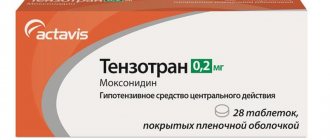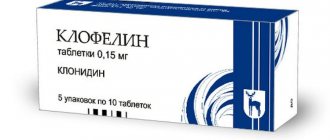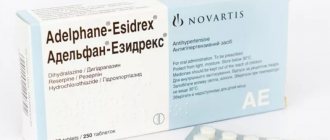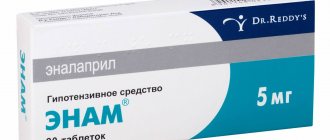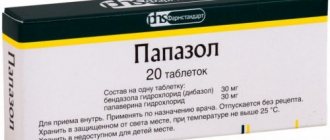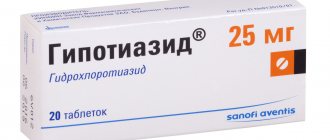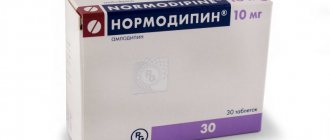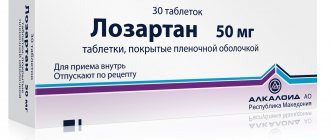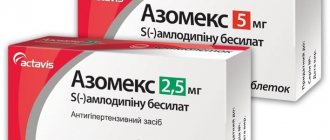Non-selective beta blockers lower blood pressure through inhibition of beta receptors. The high effectiveness of drugs in this group for hypertension has been proven; they have a complex effect on the heart and blood vessels, improving the general condition. Propranolol is a medicine that is taken orally and used as an injection. Propranolol helps with blood pressure, normalizes heart rate, and removes signs of angina. The drug is taken as prescribed by a doctor. Today the medicine can rarely be found on sale in Russia, but some pharmacies dispense the drug with a prescription.
Brief information about the drug
Release forms
The drug is produced in three types:
- tablets for oral administration;
- long-acting depot capsules;
- solution for intravenous administration and intraconjunctival use.
Compound
The composition contains only one active substance - propranolol. One tablet can contain 10, 40 or 80 mg of the substance. The solution contains 0.1% propranolol. Depot capsules contain 80 mg of the substance.
pharmachologic effect
The drug has antiarrhythmic, antianginal, antihypertensive effects.
Propranolol tablets
Manufacturer
- Weimer Pharma GmbH, Germany;
- Vector, Russia.
Terms and conditions of storage
It is recommended to store the medicine out of the reach of children. The storage mode for each release form of the drug is different and is indicated in the instructions for use of Propranolol.
The shelf life of the medicine is 5 years from the date of manufacture.
Terms of sale
The drug is dispensed in pharmacies with a doctor's prescription.
Price
The drug Propranolol can rarely be found in pharmacies. Typically, pharmacists offer active analogues or substitutes. The price of Propranolol tablets is 1300 rubles.
Prescription for children
It is not recommended to use Propranolol for children under 12 years of age, since the safety of the drug has not been established.
However, in urgent cases, when the expected benefits outweigh all possible risks, doctors use Propranolol in children.
In such cases, the dosage of the drug is calculated individually based on body weight, based on the ratio of 0.5 - 1 mg per 1 kg of body weight per day for the initial dose, and 2 - 4 mg per 1 kg of body weight per day for the maintenance dose.
The calculated daily dosage is divided into two doses per day.
Pharmacodynamics: effect on blood pressure
The drug belongs to the pharmacological class of non-selective beta-blockers. Tablets and solution have a triple effect on the body: propranolol lowers blood pressure, removes signs of angina, and normalizes heart rhythm.
The basis of the action lies in blocking beta-adrenergic receptors, reducing the conversion of cyclic adenosine triphosphate to adenosine monophosphate. Calcium moves less through slow calcium channels, its content in cells decreases, which leads to a decrease in the contractile force of the myocardium, inhibition of excitability, decreased conductivity and a decrease in heart rate.
In the first days of use, the resistance of peripheral arteries may slightly increase due to the effect on beta-adrenergic receptors. After three days, vascular resistance will return to nominal values; with further therapy it decreases significantly.
- The antihypertensive effect is due to stimulation of peripheral arteries, a decrease in the minute volume of circulating blood, an effect on the central nervous system, a decrease in the susceptibility of interoreceptors in the aorta, and a decrease in the active activity of the renin-angiotensin-aldosterone system. After two weeks of therapy, normalization of blood pressure is noted.
- The antianginal effect of the drug is due to a decrease in myocardial oxygen starvation, a decrease in heart rate, improved myocardial perfusion, and prolongation of diastole. In chronic heart failure, the opposite effect is possible in the form of increased myocardial hypoxia.
- The antiarrhythmic effect of the drug is due to the elimination of the causes of arrhythmogenicity, which include arterial hypertension, increased formation of cyclic adenosine triphosphate, increased activity of the nervous system, and increased heart rate. The drug inhibits atrioventricular conduction, reduces the rate of excitation of ectopic supraventricular and sinus rhythms.
The drug reduces the myocardial oxygen demand, thereby reducing the signs and risk of ischemia. The complex effect of the drug significantly reduces mortality after a heart attack.
The drug belongs to the group of beta-blockers
The drug prevents migraines caused by vascular spasms, reduces the dilation of cerebral vessels, reduces platelet adhesion, reduces the production of renin, and saturates tissues with oxygen.
The drug may increase the atherogenicity of blood serum. In large doses, Propranolol has a sedative effect, increases bronchial tone, and enhances uterine contractility.
Composition and release form
The trade name of propranolol in tablet form is Anaprilin.
Previously, Propranolol hydrochloride was also produced. An oral solution containing propranolol is called Hemangiol. Anaprilin (propranolol) is available in two dosages of 0.01 and 0.04 mg.
Properties
Propranolol and analogs have the following effects in the body:
- reduce blood pressure (antihypertensive effect);
- increase blood flow to the heart and reduce its need for oxygen (antianginal);
- restore heart rhythm (antiarrhythmic).
Additional effects:
- prevent the development of headaches of vascular origin;
- reduce tremor;
- increase atherogenic (promoting the development of atherosclerosis) properties of blood;
- increase uterine contraction;
- increase bronchial tone;
- in high doses cause a sedative effect;
- reduce foci of infantile hemangioma.
Pharmacokinetics of the drug
The drug is used orally, intravenously and intraconjunctivally.
The bioavailability of substances is 30-40%. Food intake and the intensity of blood flow in the hepatic veins affect bioavailability. The maximum concentration is reached 1-6 hours after administration, the indicator depends on the method of administration of the drug. Plasma protein binding is high and amounts to 90-95%. The half-life varies from 2 to 5 hours; when using the extended-release form, the time increases to 10 hours. There is a cumulative effect in the lungs, brain, kidneys, and heart muscle. The drug passes into breast milk and through the placental barrier. Metabolites are excreted through the intestines and kidneys.
Propranolol blocks anxiety, allows you to forget bad memories, blocks panic phobias
Today there are almost no safe medications available to treat post-traumatic stress syndrome. Propranolol is being investigated as a potential drug for the treatment of Post Traumatic Syndrome. Propranolol inhibits the action of norepinephrine, which promotes the consolidation of memories of bad events in life. Propranolol may also reduce the emotional distress of already formed negative memories. For this reason, it is also being studied in the treatment of specific phobias. For example, fear of spiders, fear of visiting the dentist, social phobias. Experiments have shown that if propranolol is given to people before a demonstration of spiders, then all symptoms of fear disappear. Moreover, they do not return even after the volunteers go through a second stage of the “fear of spiders” attempt. In addition, propranolol improves cognitive functions (memory, thinking, etc.) in post-traumatic syndrome
Links to studies:
- www.ncbi.nlm.nih.gov/pubmed/23182304
- www.nbcnews.com/id/10806799/
- www.ncbi.nlm.nih.gov/pubmed/17588604
- www.biologicalpsychiatryjournal.com/article/S0006-3223(03)00412-8/abstract
- https://jop.sagepub.com/content/30/2/128
- www.ncbi.nlm.nih.gov/pubmed/27014009
- www.ncbi.nlm.nih.gov/pubmed/26808441
- www.ncbi.nlm.nih.gov/pubmed/26942318
- www.ncbi.nlm.nih.gov/pubmed/26707354
- www.ncbi.nlm.nih.gov/pubmed/26487439
- www.ncbi.nlm.nih.gov/pubmed/17200914
Commonly used therapeutic agents for the treatment of anxiety disorders are selective serotonin reuptake inhibitors, tricyclic antidepressants and benzodiazepines, as well as propranolol www.ncbi.nlm.nih.gov/pubmed/8679756 www.ncbi.nlm.nih.gov/pubmed/8679756 Although a 2021 meta-analysis concludes that the quality of evidence for the effectiveness of propranolol is currently insufficient for its routine use in the treatment of anxiety disorders. www.ncbi.nlm.nih.gov/pubmed/26487439
A controlled trial in humans showed that propranolol 80 mg one hour before a dental visit and 40 mg immediately after the visit reduced anxiety before going to the dentist for a tooth extraction this time and the next.
Links to studies:
- www.ncbi.nlm.nih.gov/pubmed/26607848
Musicians, speakers, actors and professional dancers in many Western countries use propranolol to block anxiety before public speaking.
Links to studies:
- https://en.m.wikipedia.org/wiki/Beta_blocker
Propranolol improves social communication skills in people with autistic disorder
Links to studies:
- www.ncbi.nlm.nih.gov/pubmed/7903928
Theranostics of aging evaluates the diagnostic parameters of your body and informs you about existing ways to increase your life expectancy.
After diagnosing the parameters of your body (https://nestarenie.ru/novaya-teranostika-stareniya-1-5.html) at the medical center, make an appointment with a doctor .
Follow your doctor's recommendations to help increase your life expectancy. See you in the 22nd century .
What is Propranolol used for?
Indications for use of Propranolol:
- angina pectoris;
- arterial hypertension;
- sinus tachycardia;
- unstable angina;
- atrial fibrillation;
- supraventricular tachycardia;
- heart attack;
- alcohol withdrawal syndrome;
- ventricular extrasystoles;
- idiopathic tremor;
- thyroid crisis;
- Graves' disease;
- panic attacks;
- pheochromocytoma;
- increased anxiety.
Propranolol is used for various types of cardiac arrhythmias
Reviews of Propranolol
According to reviews, Propranolol effectively copes with all indications for the use of this medication. However, it is important to follow the instructions for use and dosages.
Reviews about the treatment of hemangioma with Propranolol
In 2008, French doctors identified the positive effect of this active drug on the fight against hemangioma. Also, you can already find examples of positive results of such treatment. However, one should remember about contraindications for the use of the drug, and also that today the drug is not protocol for the treatment of hemangioma, since the effect of this medication has not yet been sufficiently studied. In any case, you should definitely consult your doctor on this topic.
When use is contraindicated
Contraindications to the use of Propranolol for blood pressure:
- sinoauricular block;
- cardiogenic shock;
- gestation period;
- cardiac hypertrophy;
- variant angina;
- sinus rhythm disturbance;
- sinus node dysfunction;
- chronic decompensated heart failure;
- acute heart failure;
- increased susceptibility to components;
- chronic obstructive pulmonary disease;
- low blood pressure;
- bronchial asthma;
- dermatosis;
- muscle weakness;
- liver failure;
- lactation period;
- diabetic ketoacidosis;
- peripheral artery occlusive disease;
- violation of acid-base balance;
- parallel use of MAO inhibitors.
Propranolol should be treated with caution in cases of depression, Raynaud's disease, renal dysfunction, allergies, hyperthyroidism, in childhood and the elderly.
For depressive conditions, Propranolol is prescribed with caution.
Indications for use
for adults
Propranolol is used for the following pathologies:
- high blood pressure;
- arrhythmia;
- cardiac ischemia;
- pheochromocytoma;
- cirrhosis of the liver;
- cardiopsychoneurosis;
- hyperthyroidism;
- weakness of labor;
- hypertrophic cardiomyopathy;
- myocardial dystrophy;
- tachyarrhythmia;
- essential tremor;
- withdrawal state.
Propranolol can be used to prevent migraines.
for children
The drug is not used in pediatrics.
for pregnant women and during lactation
During pregnancy, propranolol can only be used under strict indications. It must be taken into account that it can have a negative effect on the fetus, causing intrauterine growth retardation, hypoglycemia, and bradycardia.
Propranolol is not compatible with breastfeeding.
Instructions for use and dosage
Arterial hypertension
For high blood pressure, it is recommended to take Propranolol 40 mg twice a day. If the specified dosage does not bring the expected hypotensive effect, it is increased to 80 mg twice a day or the patient is given 40 mg three times a day. The maximum dose of Propranolol for high blood pressure is 320 mg per day. In rare cases, the doctor may decide to prescribe 640 mg of Propranolol for high blood pressure if the patient's condition is severe.
Heart rhythm disturbances
For angina pectoris and heart rhythm disturbances, the doctor prescribes the drug in tablet form three times a day, 20 mg. Gradually the dose is increased to 120 mg, divided into 2-3 applications. The maximum permissible dose for arrhythmia and angina pectoris is 240 mg per day.
Migraine prevention
For migraines and idiopathic tremor, the patient is advised to take the drug 2-3 times a day, 40 mg. After 7-14 days, the dosage is increased to 160 mg per day. Long-acting depot capsules are taken once a day, 80 mg.
Thyrotoxic crisis
In case of thyroid crisis, the patient is prescribed a solution of Propranolol intravenously. The drug is administered slowly in a dosage of 1 ml. After two to three minutes, re-inject the solution in the same dosage. If the specified dose is ineffective, the doctor increases the dose to 10 ml intravenously, while simultaneously monitoring the electrical activity of the heart and blood pressure.
Stimulation of labor
For a quick delivery, a woman is given 20 mg of the drug every half hour. The maximum daily dosage is 80-120 mg. If there is oxygen deficiency in the fetus, the dose must be reduced. If renal function is impaired, there is no need to adjust the prescribed dose. For liver abnormalities, the dosage is reduced.
A doctor may prescribe the drug to a woman after delivery to reduce the likelihood of complications. The preventive dose is 20 mg three times a day. The drug is taken for 5 days.
Treatment of infantile hemangioma
Definition of pathology
Infantile hemangioma is the most common vascular benign tumor (5-10%) in young children, more often in girls. In the first weeks and months of a child's life, it is characterized by rapid growth. Further, spontaneous resorption may occur (source No. 4).
Causes
The exact reasons for the development of pathology have not been established; there are only theories:
- viral infection in a pregnant woman in the first trimester, when the formation of the fetal vascular system occurs;
- multiple pregnancy;
- woman's age over 38 years;
- prematurity;
- Rh conflict between the blood of the child and mother;
- endocrine pathologies of the mother/fetus system;
- arterial hypertension of a woman during pregnancy.
However, hemangiomas often develop in healthy, full-term children, when the woman’s pregnancy is going well.
Dangerous consequences
Some tumors, due to their size and location, predispose to complications:
- permanent deformity;
- functional disorders leading to mortality;
- ulcerations (formation of ulcers on tissues) and their infection.
Therapy
It is recommended to treat extensive infantile hemangioma in order to prevent the development of these complications.
Instructions for the use of propranolol for newborns and young children list situations for using the drug:
- for stopping tachycardia;
- for arrhythmia;
- with neonatal hyperthyroidism.
However, the instructions for the drug propranolol do not contain information on the treatment of hemangiomas. However, in the treatment of vascular tumors, doses of oral drugs are used slightly lower than for the listed pathologies. This is taken orally at a dose of 1-3 mg per kg of child’s body weight per day and the medicine is well tolerated by young patients (source No. 5).
Also, in areas of local hemangiomas that are not life-threatening, a gel or ointment of 1-2% with propranolol or a gel with timolol maleate 0.5% is used externally, 2 times a day to reduce redness (source No. 5).
Mechanism of action of the drug
It is based on a decrease in blood flow to tumor sites due to beta-adrenergic blockade of blood vessels and other complex tissue structures.
History of discovery
Until recently, the pathology was treated with corticosteroids. In 2008, a team of scientists found an occasional beneficial effect of propranolol in 11 children with similar tumors. Since then, this discovery has revolutionized the medical treatment of infantile hemangioma, which has been confirmed by hundreds of studies. As a result, the high effectiveness of the substance for partial or complete resorption of vascular tumors in infants was determined.
Effectiveness studies
According to the results of one clinical study, 5 weeks of therapy with a drug containing propranolol for hemangioma in children was accompanied by positive dynamics in 88% of cases. The result was recorded in patients regardless of age (35-90-150 days), gender and location of the vascular tumor on the body/head¹.
Features of treatment
It is necessary to separately highlight the existence of a risk of low blood glucose levels (hypoglycemia) and seizures associated with it. This side effect is provoked by long periods of fasting of the child or poor appetite.
To prevent the development of symptomatic hypoglycemia during treatment with propranolol, it is recommended to feed the baby frequently, use a balanced diet, and avoid long periods of sleep, which significantly minimizes the risk of side effects.
Currently, infantile hemangioma is treated with propranolol, which is a 1st-line drug. Also, other methods of influencing pathological tissue can be used: sclerosis, cryodestruction, laser exposure and x-ray therapy. Unfortunately, most of these methods are aggressive.
special instructions
Pheochromocytoma
Propranolol tablets can be used for blood pressure once the diagnosis has been established only after completing a course of alpha-blockers. Patients with hyperthyroidism should not abruptly stop taking Propranolol if they have high blood pressure, since abrupt withdrawal may provoke an increase in the symptomatic manifestations of the disease. Taking the drug may hide some symptoms of the disease.
Diabetes
Diabetics should take the drug with caution, as hypoglycemia may develop when taking Propranolol in combination with antidiabetic drugs.
Propranolol may mask symptoms of developing hypoglycemia, which include trembling limbs and rapid heart rate. Patients with diabetes should be warned that increased sweating will be a sign of low blood sugar.
The drug can be taken strictly as prescribed by a doctor.
General anesthesia
The drug should not be prescribed for hypertension before an upcoming surgical procedure using drugs for general anesthesia. If you have high blood pressure, you should stop using Propranolol two to three days before your upcoming surgery.
Before surgery, it is necessary to inform the anesthesiologist about taking Propranolol so that he can select a medication for general anesthesia with less impact on reducing the force of heart contraction.
Pregnancy and lactation
The medicine Propranolol is prescribed for blood pressure during pregnancy and lactation only in exceptional cases, if the benefit to the mother’s health outweighs the possible risk to the unborn child. When taking a course of Propranolol during gestation, it is necessary to monitor the condition of the mother and child. The medication should be stopped two to three days before the expected date of birth.
The components of the drug pass into breast milk, so women should avoid taking the medication while breastfeeding their baby. If treatment with the drug is necessary, doctors recommend stopping breastfeeding.
Transport management
Doctors recommend refraining from driving or performing work that requires increased concentration, since the medication has a strong effect on the nervous system and the speed of psychomotor reactions.
Elderly age
In old age, the drug Propranolol for blood pressure should be used with extreme caution. A dose adjustment downward is required for elderly patients with ventricular extrasystole, bronchospasm, atrioventricular block, low blood pressure, bradycardia, hepatic or renal failure. Patients over 65 years of age should regularly monitor their kidney function.
Other recommendations
If a depressive state develops while taking Propranolol, you should consult a doctor and choose another drug from existing analogues.
Do not suddenly stop taking the medication, as this may lead to a sudden heart attack or severe forms of heart rhythm disturbances. The drug is discontinued in stages, gradually reducing the daily dosage by 25% every three days. It will take 14 days to discontinue the drug.
When taking Propranolol tablets, it is necessary to monitor blood glucose levels, electrical activity of the heart, blood pressure, and pulse value. The doctor must explain to the patient the rules for independently determining the heart rate.
When smoking, the effectiveness of the drug decreases and dose adjustment is required.
When wearing contact lenses, you will need to use drops to eliminate dry eyes, since the medication reduces the formation of tear fluid.
If you wear contact lenses, you will need to use additional drops for dry eyes.
Contraindications
Propranolol should not be taken if the patient has the following pathologies:
- bronchial asthma and COLD;
- severe form of bradycardia;
- peripheral circulatory disorders;
- arterial hypotension;
- sinoatrial and atrioventricular block;
- Raynaud's syndrome;
- unspecified and decompensated heart failure;
- cardiogenic shock;
- chronic liver pathologies;
- acidosis;
- acute myocardial infarction;
- individual intolerance to the composition of the medication.
Propranolol should not be taken in combination with MAO inhibitors, anesthetics that inhibit myocardial function, or during insulin therapy.
Manifestations of side effects
Taking the medication may cause side effects:
- nervous system: sleepiness, fatigue, nightmares, dizziness, lethargy, tremors of the limbs, paresthesia, depression, memory disorders, mental confusion, anxiety, headaches, muscle weakness, asthenic syndrome, imaginary visions;
- organs of perception: inflammation of the cornea and conjunctiva, eye diseases, decreased production of tear fluid, dry eyes, temporary blurred vision;
- heart and blood vessels: heart rhythm disturbance, cardiac conduction disturbance, rapid heartbeat, sinus rhythm disturbance, increased signs of heart failure, decreased myocardial contractility, chest pain, acute vascular dystonia, Raynaud's disease, cold legs, impaired blood microcirculation, decreased arterial pressure to critical levels, orthostatic collapse;
- digestive system: taste disturbance, liver dysfunction, cholestatic syndrome, jaundice, dark urine, indigestion, bloating, pain in the epigastric region, vomiting, dry mouth;
- respiratory organs: narrowing of the lumen of the small bronchi, involuntary contraction of the muscles of the larynx, respiratory failure, runny nose;
- endocrine system: decrease or increase in blood glucose, hypothyroidism;
- allergic reactions: nettle fever, skin rashes, itching, dermatosis, psoriasis-like changes, baldness, exanthema, redness of the skin, hyperhidrosis;
- laboratory indicators: increased activity of liver aminotransferases, lack of platelets, decreased number and level of leukocytes, increased level of bilirubin in the blood;
- impact on the intrauterine condition of the fetus: sinus rhythm disturbance, low glucose levels, developmental delay;
- other reactions: decreased libido, joint pain, back pain, withdrawal reaction, increased angina attacks.
Propranolol helps improve athletic performance and shooting accuracy
Propranolol lowers heart rate and reduces tremors. Therefore, propranolol and other beta blockers are used in some sports where high accuracy is important: archery, billiards, golf, pistol shooting, etc. But today beta blockers are prohibited by the International Olympic Committee. The last high-profile crime occurred in 2008 at the Summer Olympic Games. Bronze medalist in shooting Kim Yong-Soo was stripped of his bronze medal due to the use of beta blockers. For the same reasons, beta blockers are used by neurosurgeons.
Links to studies:
- https://en.m.wikipedia.org/wiki/World_Anti-Doping_Agency
- www.ncbi.nlm.nih.gov/pubmed/10360293
- www.ncbi.nlm.nih.gov/pmc/articles/PMC1298399
Essential tremor is the most common movement disorder and its cause is unknown. Usually involves tremors of the arms, hands, or fingers, but sometimes the head, vocal cords, or other parts of the body are involved during intentional movements such as eating or writing. It is a separate disease from Parkinson's disease and is often misdiagnosed because some features are common to both conditions. Propranolol is the only drug approved by the US Food and Drug Administration (FDA) for the treatment of essential tremors.
Links to studies:
- www.ncbi.nlm.nih.gov/pubmed/24385718
- www.ncbi.nlm.nih.gov/pubmed/22013182
Overdose of Propranolol
In case of overdose, patients may experience characteristic symptoms:
- bronchospasm;
- loss of consciousness;
- cyanosis of nails;
- ventricular extrasystoles;
- sinus rhythm disturbance;
- heart failure;
- seizures;
- heart rhythm disturbance;
- a strong decrease in blood pressure to critical levels;
- AV block;
- dizziness.
Dizziness and sudden deterioration in well-being may be symptoms of an overdose
Treatment of overdose with Propranolol tablets:
- if there are signs of overdose, it is necessary to rinse the stomach and drink the adsorbent;
- with a strong decrease in pressure, the patient should be laid horizontally with his legs raised;
- if the conduction of the heart is impaired, it is necessary to give an intravenous injection of atropine; if there is no positive result, a pacemaker is installed;
- in case of bronchospasm, it is necessary to give the patient beta-agonists by injection or inhalation;
- for convulsive seizures, diazepam drip administration will help;
- in case of heart failure, you should take a diuretic tablet, cardiac glycoside, glucagon.
Analogs
There are quite a lot of analogues of this drug. The following can be considered a replacement for Propranolol:
- Bisoprolol.
- Anaprilin.
- InderalInderal.
- Obzidan.
- Atenolol.
- Betacom.
- Binelol.
- Betacard.
- Aritel.
- Breviblock.
- Corvitol.
- Coronal, etc.
Despite the similar therapeutic properties of the analogues, there are some differences between them. Therefore, you should not look for substitutes on your own if this medicine does not suit you. It is better if a competent specialist does this.
Drug interactions
Taking the medication Propranolol for blood pressure can lead to changes in the pharmacological properties of other drugs:
- Skin testing allergens increase the risk of developing severe allergies;
- radiopaque iodine-containing drugs increase the likelihood of developing anaphylactic shock;
- intravenous use of phenytoin and drugs for general anesthesia can lead to a sharp decrease in blood pressure to critical levels;
- Propranolol reduces the effectiveness of antidiabetic drugs and insulin;
- the use of Propranolol tablets increases the concentration of xanthines and lidocaine in the blood;
- non-steroidal anti-inflammatory drugs reduce the antihypertensive effect;
- antiarrhythmic drugs, slow calcium channel blockers, cardiac glycosides, amiodarone, guanfacine, reserpine, Methyldopa tablets increase the likelihood of developing heart failure, heart block, and sinus rhythm disturbances;
- antihypertensive drugs, sympatholytics, diuretics, Hydralazine, Nifedipine, Clonidine can provoke a sharp decrease in blood pressure to critical levels;
- Propranolol enhances the anticoagulant effect of coumarins and muscle relaxants;
- the use of sleeping pills, sedatives, antipsychotics, tricyclics, tetracyclines can lead to the development of depression;
- Monoamine oxidase inhibitors enhance the hypotensive effect of Propranolol.
Propranolol may be incompatible with other drugs
Propranolol prolongs life and reduces mortality from recurrent heart attack and stroke
Beta-blockers (preferably non-selective - propranolol or carvedilol) are indirect mTOR inhibitors. Substances that can inhibit mTOR are candidates for the role of anti-aging drugs. It is the mTOR gene that plays one of the leading roles, thanks to which reducing caloric intake can prolong life.
In addition, propranolol suppresses stress through blockade of receptors for stress hormones. Stress greatly shortens our life and accelerates aging, creates wrinkles, raises blood pressure, damages the heart and blood vessels, shortens telomeres, and reduces the level of longevity protein Klotho.
The fact that emotional stress increases blood pressure and causes heart disease is clearly shown in the work of J. Kaplan. Using primates as an example, Kaplan showed that if you gather a group of male primates, then within a few days the monkeys will develop a social hierarchy. The worst place in such a hierarchy is at the bottom. Male primates in subordinate positions exhibit a range of indicators of chronic stress. Often such primates develop atherosclerosis. But if scientists gave male primates at the bottom of the social hierarchy (at risk) beta blockers, which suppress the activity of the sympathetic nervous system, then they did not develop vascular atherosclerosis. This showed how the sympathetic nervous system, due to stress, negatively affects the development of atherosclerosis and is involved in problems with the heart and blood vessels. The truth is that emotional stress manifests itself through the sympathetic (adrenergic) autonomic nervous system, which connects the control centers of our brain and internal organs. Including immune, bone marrow, etc. And atherosclerosis is the main factor that leads to the largest number of deaths in developed countries from heart attack and cerebral stroke.
Link to the study:
- www.ncbi.nlm.nih.gov/pubmed/2899392
Clinical trials in humans have shown that propranolol reduces mortality from cardiovascular disease (the No. 1 cause of death in the world),
Link to the study:
- www.ncbi.nlm.nih.gov/pubmed/6342840
A 3-year observation of patients aged 60-69 years who suffered a myocardial infarction showed that propranolol reduced overall mortality in such patients by 23-37%. In addition, propranolol caused a decrease in signs of heart disease and aging (a significantly greater increase in left ventricular ejection fraction and a significantly greater decrease in left ventricular myocardial mass.
Links to the study:
- www.ncbi.nlm.nih.gov/pubmed/9230162
- www.ncbi.nlm.nih.gov/pubmed/6342843
- https://pda.rlsnet.ru/mnn_index_id_370.htm
- www.ncbi.nlm.nih.gov/pubmed/6342840
- www.ncbi.nlm.nih.gov/pubmed/3903736
- www.ncbi.nlm.nih.gov/pubmed/10381708
In animal studies, the lipophilic metaprolol administered daily starting at 12 months of age extended the median lifespan of long-lived male mice by 10% (www.ncbi.nlm.nih.gov/pubmed/23314750). A 2021 meta-analysis of 90,935 patients concludes that lipophilic beta-blockers (metoprolol, propranolol and oxyprenolol) are significantly better at reducing the risk of CVD mortality than hydrophilic beta-blockers (atenolol, etc.) (www.ncbi.nlm.nih .gov/pubmed/28760243). Atenolol (a hydrophilic beta-blocker) is associated with an increased risk of stroke in older adults, whereas lipophilic beta-blockers, mainly metoprolol and propranolol (moderate to highly lipophilic) do not increase the risk of stroke in this population. In addition, drugs with high lipophilicity may more easily penetrate the brain and cell membrane, which may help prevent stroke and cardiac mortality, indicating that beta blockers with moderate to high lipophilicity may have a greater impact on clinical outcomes than hydrophilic ones beta blockers.
Currently, propranolol is being considered for the treatment of resistant hypertension, together with other blood pressure medications, when other medications are insufficient to control blood pressure.
Link to the study:
- www.ncbi.nlm.nih.gov/pubmed/28292320
